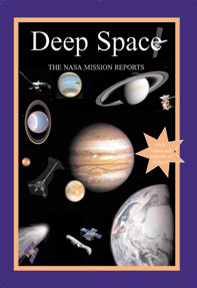
Deep Space ISBN 9781894959155 $44.95 Canadian
$34.95 American
£22.95 UKClick on item #31 in the shopping cart to buy this book. | Deep Space
The Nasa Mission Reports
by Robert Godwin Continuing with Apogee’s acclaimed NASA Mission Reports Series this latest entry covers all of the unmanned deep space probes including Pioneer 10 & 11, Voyager 1 & 2, Galileo and Cassini, NEAR, Stardust and Deep Space One.
With all of the press kits and flight data for each of the deep space probes including all of the latest information on Cassini’s mission to Saturn.
This is the most comprehensive study of NASA’s Deep Space Probe Program ever published!
The bonus DVD includes thousands of images from each of the probes. 468 Pages
Paperback
Includes bonus DVD | On Back of Book: Most of the rest of what we know of our outer solar system has been learned in the last 30 years, beginning with the Pioneer and Voyager missions of the 1970s to Jupiter and beyond. And a staggering amount has been learned in those three decades, some of it far more fascinating and complex than had ever been foreseen. Theories of planetary evolution and behavior have been revised again and again in the face of hard data returned by the scientific instruments of solar system exploration missions years in length. In the summer of 1989, Voyager 2 did a flyby of Neptune, the first spacecraft to do so, a full 12 years after it was launched. The Galileo spacecraft, launched in 1989, was the first outer solar system orbiter, going into orbit around Jupiter in 1995 to begin a two-year intensive study of the planet. Galileo released the first-ever probe into the atmosphere of another planet. The Cassini spacecraft was launched in 1997, spent seven years reaching Saturn, and then went into orbit to begin a multi-year study of the Saturnian system. On January 14, 2005, Cassini released the Huygens probe, which entered the atmosphere of Titan, Saturn's largest moon, and parachuted to the surface, radioing scientific observations back to Cassini for relay to Earth. Titan' s atmosphere resembles that of primordial Earth and scientists feel that much can be learned about our own world's evolution by studying what's happening now on Titan. Cassini and Huygens are the latest spacecraft in an ongoing long-term effort that has become international in scope, exploring the solar system to help understand the past and prepare for the future. |
|
